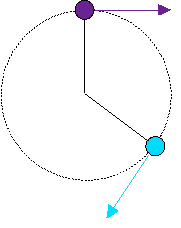Think of spinning an object on the end of a string. How would you describe it to someone?
- The easiest thing to say is that it moves in the shape of a circle.
- This means you should be able to measure the radius of the circle, and from that calculate things like circumference.
- You might also notice that since it is going in a circle, the motion of the bob as it moves around repeats itself over and over again.
- We refer to this as periodic motion, because periodically ("every so often") it gets back to where it started and keeps on going.
- Other objects, like pendulums, can also be described as periodic, as long as they repeat the same motion over and over again.
- The bob is also an example of two dimensional motion, just like a projectile.
- It is moving in the x and y directions at the same time, not in a perfect straight line.

You might remember that when we originally talked about acceleration we defined it as a change in the speed and/or direction of the movement of an object.
While the bob is going around in a circle, its speed might be constant (and usually will be in the problems you do), but what is happening to the direction it is traveling?
- At any particular instant in time, the velocity of the bob spinning in a circle is pointing in the same direction as the tangent line to the circle.
- In Figure 1 you can see that the velocity vectors are pointing in different directions as the object moves clockwise.
- That means that the direction the bob is traveling is constantly changing!
- By definition, this means that the bob is accelerating.
- If it wasn’t accelerating, it would be traveling in a straight line.
- So how do we calculate the acceleration of the bob?
Some textbooks will start showing you all these fancy diagrams and talk about things like “chords” to explain how they figured out a formula for the acceleration of an object moving in a circle.
Does this really help you understand the formula any better? I don’t think so. It seems like students usually get really concerned about trying to figure out this weird math that they might not have seen before, and completely forget about the end result.
So, instead, here’s the formula for you…

ac = centripetal acceleration (m/s2)
v = velocity (m/s)
r = radius of the circle (m)
Notice I called the acceleration “centripetal”.
- Centripetal comes from Greek meaning “centre seeking”
- The bob is basically being pulled in towards the centre of the circle, which is why it follows a curved path around the centre. It’s as though it were seeking the centre of the circle, even though it never gets there.
- Do not confuse this with the word “centrifugal”, which doesn’t even exist!
- A person in a car going around in a circle might say that a “centrifugal force” was pushing them across the seat out of the circle.
- In fact, it is just your body obeying Newton’s first law… it is trying to move in a straight line.
- The car is trying to keep you going in a circle, which is centripetal.
Example 1: What is the centripetal acceleration of a person in a car driving at 60km/h in a traffic circle that is 120m across?
Change the velocity into metres per second, and since the measurement of the circle is a diameter, divide it by two.
v = 17 m/s
r = 60.0 m
ac= ?ac= v 2 / r
= 172 / 60.0
ac= 4.6 m/s2